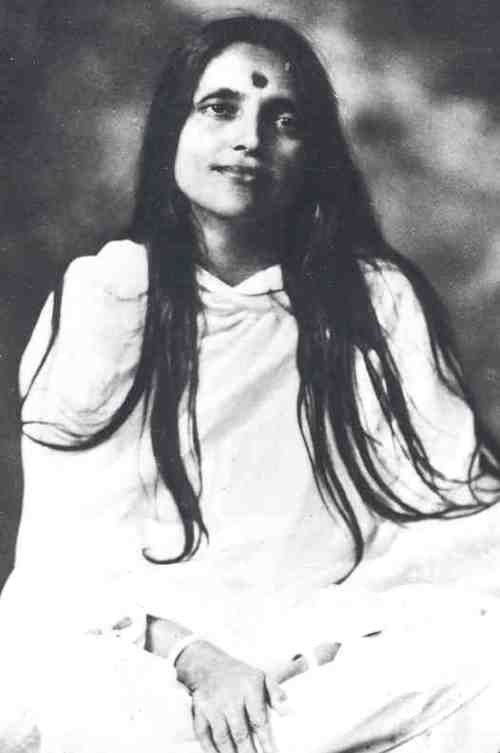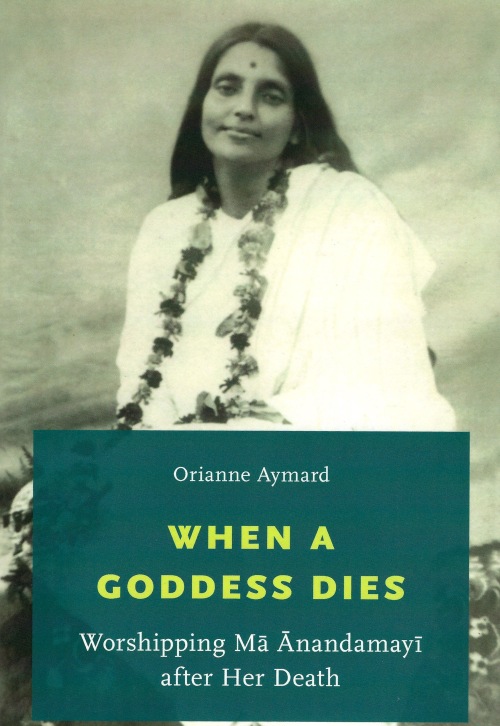The Power of a Photograph
In the last couple of years
I’ve read whatever books I could get my hands on
Whose subject is Sri Anandamayi Ma
(Her parents gave her the name
Nirmala Sundari
Which means “One of Taintless Beauty”)
Some say this Bengali woman
Was a saint
Others assert a guru
Still others disagree
She was undoubtedly an avatar
No, no, she was the Divine Mother herself
But this stood out to me from one of those books
A European happened to come across
A photo of her
And was so taken by it
So awakened by it
So lured by it
That in no time
She dropped everything
And left behind her middle-class life
And found herself on a plane to India
For if a mere photo had that kind of power
What would it be like to see Ma face to face?
After Hamlet Beheld Sri Anandamayi Ma
What an uncanny phenomenon is this being!
How penetrating in perception!
How infinite in faculties!
In form and moving how joyous and marvelous!
In action how like an angel!
In apprehension how like a goddess!
The beauty of the world!
The paragon of the sages!—
May I remain near this quintessence of bliss!
I Beseech You, Orianne Aymard
Peace and harmony appear so closely woven in every cell of her being that the spirits of darkness would search in vain for a loophole.
–Melita Maschmann, Encountering Bliss: My Journey through India with Ānandamayī Mā
My PhD was in the area of Religion and Society, sociology religion and social ethics, at the Graduate Theological Union in Berkeley. Previously, as Master’s student at the Maryknoll School of Theology, I studied with Venezuelan sociologist Otto Maduro, who had written a sociology of Latin American religion employing ideas from Pierre Bourdieu. It was an exhilarating study which made sense of that part of the Catholic Church that had been making a preferential option for the poor.
Over the last several years, I’ve read several works on the life and influence of the Bengali spiritual force, Sri Anandamayi Ma. I was delighted to read a new book by Orianne Aymard, who employs theorists like Bourdieu, Jurgen Habermas, and Max Weber to make sense of how a community and institution continue after the death of the charismatic leader. Her title reveals the stakes of this inquiry: When a Goddess Dies: Worshipping Ma Anandamayi after Her Death (Oxford University Press, 2014). The author investigate topics like the postmortem cult of the guru, the significance of relics, the meanings of the guru’s death, dreams and visions of the guru after death, and the future of the cult, given the struggle over the monopoly of religious power.
***
Dr. Aymard interviewed devotees, both Indian and Western, old-timers and new enthusiasts, and I found fascinating what they had to say about her. Here is a small sample:
“I don’t feel she has gone from this world. She is everywhere. Ma is here and there. She is watching everything, every aspect of our life.” [128]
“Ma is my friend, philosopher, guide, everything. I am sitting on her lap. Why would I want anybody else?” [157]
“I saw many people who followed Ma in a bit of an addicted way, as psychological dependence and she had to respond. That becomes complicated.” [171]
“My aim is to achieve Ma or God. The only important thing for me is to live always in the presence of Ma.” [191]
“Ma was such an extraordinary being and her life is quite amazing. Only a very small amount has been translated.” [205]
“Ma was Pakistani actually, not Indian.” [232]
***
When a Goddess Dies is an impressive, sophisticated theoretical work. Yet there is a small, subtle thread of something here that transcends academic research and objective tone. In her acknowledgments, I read the following:
“If this book is a great intellectual adventure, it is also much more. Its birth took place on a hospital bed in Dehra Dun, in Northern India. While in a critical medical state, I promised myself to write on Mā Ānandamayi (Mā), if I came through the crisis. Having made this promise, I had no other choice but to persevere until I published. This book, then, is a real liberation and represents a true victory of life over death.” [ix]
Her last two acknowledgments:
“In memoriam, Swami Vijayānanda, the greatest magician I have ever met, for teaching me the ‘Gai Savoir,’ the path of Joy, and for caring after me in certainly the most critical moment of my life.
And finally, the Supreme Divine Mother, to Mā Ānandamayī, without whom none of this would be possible.” [xi]
In her conclusion, the last page has a photo of the author with Swami Vijayānanda, dated January 2010.
Dear Dr. Aymard, some academics will truly appreciate your knowledge and insight on the scholarly questions animating your research. Even as I am aware of your evident modesty, I encourage you to consider writing a personal account of the stories that are behind these brief affirmations in the opening of your book. Many more people in various walks of life could benefit from your testimony about the central place of these two radiant figures in your life.
With Anandamayi Ma at Gelateria
After meditating way past midnight
I went to my mat and fell asleep
And soon in a dream
Sri Anandamayi Ma and I are having a tête-à-tête
She looks mid-twenties
She is wearing a tie-dye t-shirt
And is sitting across from me
Outside at Gelateria
The curious passers-by
Might assume she is a medical student
Taking a break from her books
That would account for the light emanating from her
She’s wearing a faint smile
And I’m a little nervous
She obviously knows this too
And tries to put me at ease
“You know you strike me
As a little confused
(I’m thinking: Her Bengali-accented
English is pretty good)
There are very few things
You need to remember…
If you all you do is exert effort
To remember each minute
Then you’ll make progress
You’ll see progress
Others will see progress too…
Now isn’t that a happy thought?
So, Shimmelevsky, I tell you
There’s nothing new
In what I have to say to you
Just a few applications
You are not your body
You are not your mind
You are not your library
You are not your publications
You are not your fan club
You are not your home
You are not your sporty little Fiat
You are not your small portfolio
(‘How did she know
About those meager–
And dwindling–
Investments?’)
You are not your curriculum vitae
Remember how you tell your students
‘You are not your GPA’?
You must practice what you preach
You are not your Twitter followers
You are not your awards from the university
You certainly are not your social networks
You are not your community service hours
You are not those thousand thoughts
You believe you are
You are not those same hundred stories
You play over and over in your mind
You are not your U.S. passport
You are not your professor identity
You are not what people say you are
You are not what people say you are not
You are not your green eyes
That have gotten you into trouble
You are not that half-smile
That seems to seduce a certain kind of personality
You are not who you think you are
You are not all that sitcom conditioning
You are not all those layers of academic indoctrination
You are not all that middle-class māyā …”
So I blurt out:
“But Srimatiji
Tell me then–
Who am I really?”
She smiles at me so beautifully
And I feel her eyes penetrating through all my layers
And she is seeing and loving me in all of that
And she begins to speak
And then I wake up
Immersed in samsara
Slowly I come to sitting
And begin meditating
Seeing
1.
Since coming to Sri Ramakrishna, M. had lost all relish for lectures and for books written by English scholars. The only thing that appealed to him now was to see the Master day and night, and hear the words that fell from his blessed lips.
2.
The philosophers and scholars said to Sri Anandamayi Ma: “We have studied dry scriptures. But, we now see before us, a living embodiment of all that is contained in our holy books of wisdom.
This page is part of my book, Dear Love of Comrades, which you can read here.

